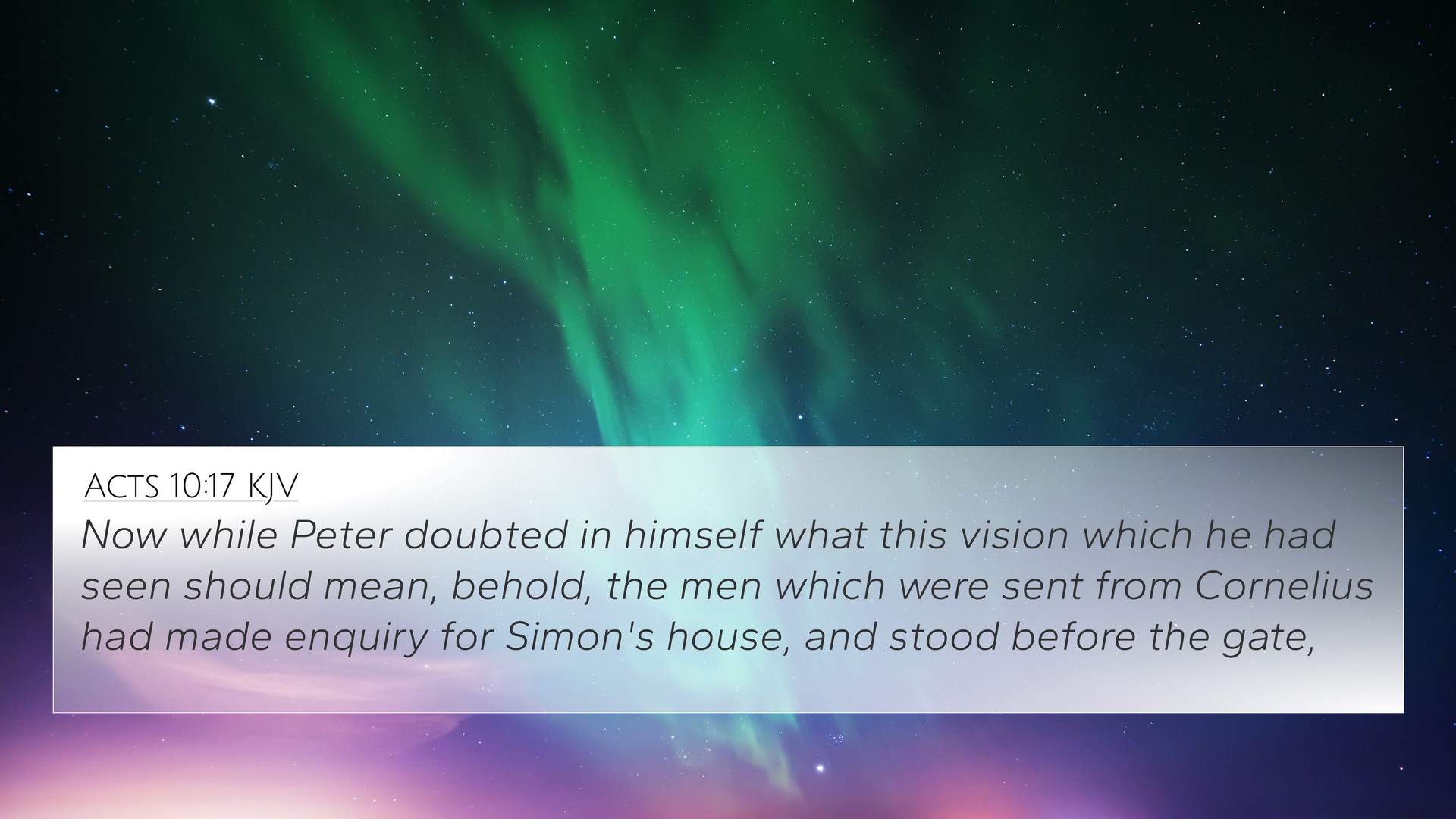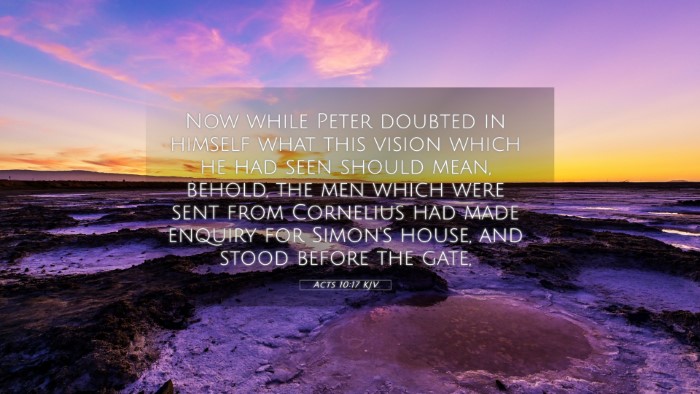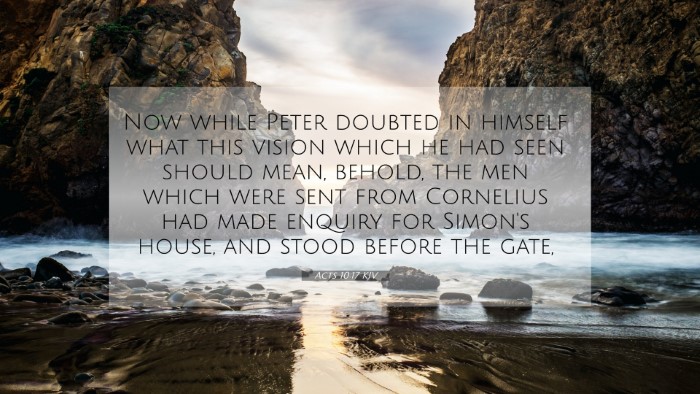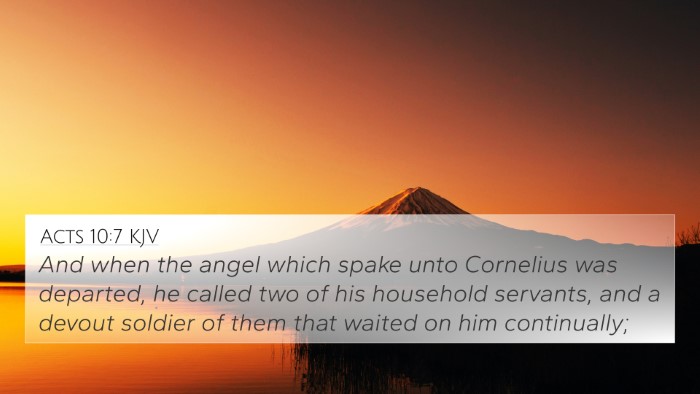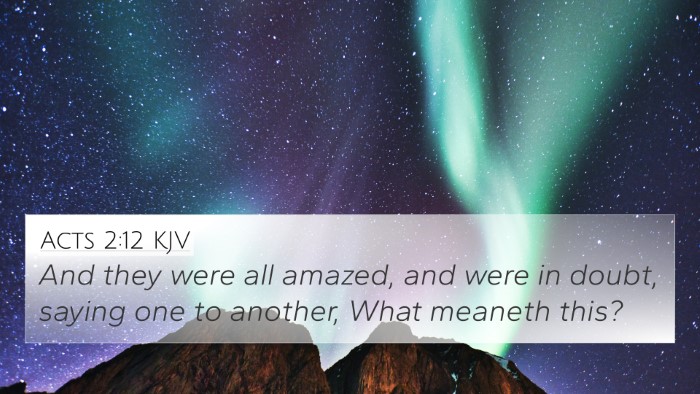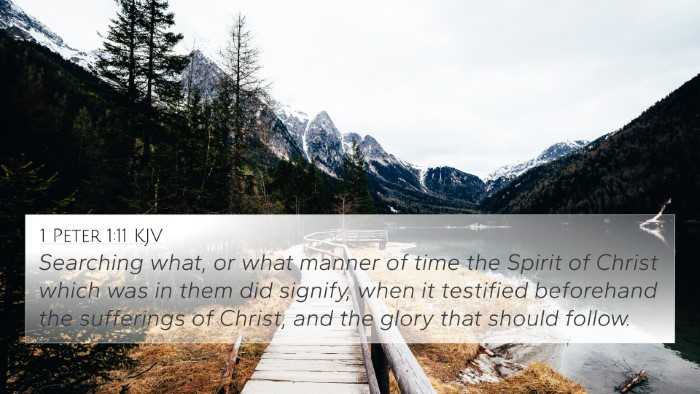Understanding Acts 10:17
Acts 10:17 reads, "Now while Peter doubted in himself what this vision which he had seen should mean, behold, the men which were sent from Cornelius had made inquiry for Simon's house, and stood before the gate." This verse encapsulates a pivotal moment in the early Christian church, where divine revelation meets human uncertainty.
Contextual Background
This verse occurs within the narrative of Peter’s vision concerning unclean animals and God’s command to eat, which symbolizes the inclusion of Gentiles into the Christian faith. The context sets the stage for understanding the significance of Cornelius and the broader implications for the church’s mission.
Commentary Insights
- Matthew Henry's Commentary: Henry emphasizes that Peter's doubt reflects a common human experience when confronted with divine revelations. It's important to approach God's visions with humility and openness, as they often challenge our preconceived notions and lead to greater truths.
- Albert Barnes' Notes: Barnes points out that the timing of the men sent from Cornelius coinciding with Peter's vision illustrates divine orchestration. This intersection of events demonstrates God's intent to reach out to the Gentiles, showing that His plans often transcend human understanding.
- Adam Clarke's Commentary: Clarke elaborates on Peter's state of mind, highlighting his confusion and the necessary preparation God provides for Peter to overcome his prejudices against Gentiles. Clarke indicates that this moment is crucial for the Gospel's expansion beyond the Jewish community.
Thematic Connections
The concept of divine revelation mingled with human doubt is a recurring theme throughout the Bible. Acts 10:17 serves as a compelling entry point for examining the broader biblical narrative concerning God's inclusive vision for humanity.
Key Cross-References
- Matthew 28:19-20: The Great Commission where Jesus commands His disciples to make disciples of all nations, correlating with the inclusion of Gentiles.
- Acts 2:17: Peter's previous experience of receiving visions aligns with God's promise of pouring out His Spirit on all flesh.
- Romans 11:17-24: Paul discusses Gentiles' grafting into the olive tree, relating to the same theme of inclusion.
- Galatians 3:28: Paul declares that in Christ there is neither Jew nor Gentile, indicating the breaking of cultural barriers.
- Isaiah 49:6: The prophetic statement of being a light for the Gentiles reflects the fulfillment found in Acts 10.
- John 10:16: Christ’s statement about having other sheep not of this fold points to His mission extending beyond Israel.
- Acts 11:18: The reaction of the apostles upon learning that Gentiles had received the word of God provides insight into the acceptance of God's vision.
- Luke 4:25-27: Jesus mentions Elijah and Elisha’s ministry to Gentiles, serving as further affirmation for Peter's unfolding revelation.
- Romans 10:12: An affirmation of both Jews and Gentiles having equal access to God's grace.
- Ephesians 2:12-13: A reminder of the Gentiles' inclusion in the covenant of Christ, echoing the themes from Acts 10.
The Importance of Cross-Referencing
Cross-referencing Bible verses enhances our understanding of scripture. By identifying connections between Bible verses, one can unravel the intricate web of themes and teachings that run throughout the Bible. This practice not only deepens one’s theological insights but also enriches personal faith and understanding of biblical narratives.
Tools for Bible Cross-Referencing
- Bible Concordance: A useful tool for locating specific verses and their thematic connections throughout scripture.
- Bible Cross-Reference Guide: Guides readers to similar scriptures, illuminating inter-Biblical dialogues and thematic connections.
- Cross-Reference Bible Study: A method that encourages readers to explore how different verses relate to one another.
- Comprehensive Bible Cross-Reference Materials: Resources that provide extensive lists of cross-referenced verses to aid study.
- How to Use Bible Cross-References: Learning how to effectively navigate and apply cross-references can significantly advance biblical study.
Conclusion
Acts 10:17 serves as a cornerstone for understanding the shift in the early church's approach to evangelism and inclusion of Gentiles. By employing cross-referencing methods and delving into various commentaries, one can gain a more profound comprehension of this pivotal moment in biblical history. The interconnectedness of scripture offers a rich tapestry of meaning that encourages continued exploration and understanding of God's mission for all humanity.
